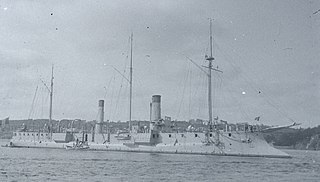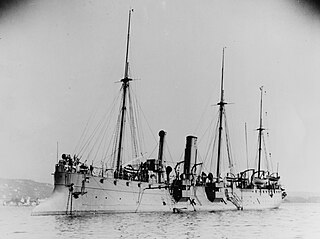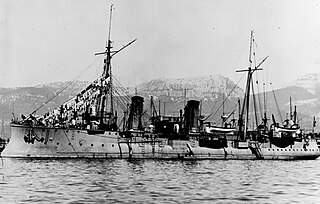
The Dévastation was an Dévastation-class ironclad battleship of the French Navy of central battery (casemate) design. She was used as a school ship for manoeuvres.

Jean Bart was a protected cruiser of the Jean Bart class built for the French Navy in the late 1880s and early 1890s. The lead ship the class of two ships, Jean Bart and her sister ship were ordered during the tenure of Admiral Théophile Aube as Minister of Marine according to the theories of the Jeune École doctrine. The ships were intended as long-range commerce raiders, and they were armed with a main battery of four 164 mm (6.5 in) guns, were protected by an armor deck that was 50 to 100 mm thick, and were capable of steaming at a top speed of 19.5 knots.

Courbet was an Dévastation-class ironclad central battery battleship of the French Navy.

Jurien de la Gravière was a protected cruiser built for the French Navy in the late 1890s and early 1900s, the last vessel of that type built in France. Intended to serve overseas in the French colonial empire, the ship was ordered during a period of internal conflict between proponents of different types of cruisers. She was given a high top speed to enable her to operate as a commerce raider, but the required hull shape made her maneuver poorly. The ship also suffered from problems with her propulsion machinery that kept her from reaching her intended top speed. She carried a main battery of eight 164 mm (6.5 in) guns and was protected by a curved armor deck that was 35–65 mm (1.4–2.6 in) thick.

D'Estrées was the lead ship of her class of protected cruisers built for the French Navy in the late 1890s. The class was ordered as part of a construction program directed at strengthening the fleet's cruiser force at a time the country was concerned with the growing naval threat of the Italian and German fleets, and were intended to serve overseas in the French colonial empire. D'Estrées was armed with a main battery of two 138 mm (5.4 in) guns, was protected by an armor deck that was 38 to 43 mm thick, and was capable of steaming at a top speed of up to 20 to 20.5 knots.

Amiral Cécille was a protected cruiser of the French Navy, named in honour of Jean-Baptiste Cécille. The third vessel of that type built in France, her design was derived from her two predecessors, Sfax and Tage. Like those vessels, Amiral Cécille was intended to be used as a commerce raider to attack merchant shipping. As such, she carried a barque sailing rig to supplement her steam engines for long voyages overseas. Amiral Cécille was armed with a main battery of eight 164 mm (6.5 in) guns and had a curved armor deck that was 56 to 102 mm thick.

Guichen was a large protected cruiser built in the 1890s for the French Navy, the only member of her class. She was intended to serve as a long-range commerce raider, designed according to the theories of the Jeune École, which favored a strategy of attacking Britain's extensive merchant shipping network instead of engaging in an expensive naval arms race with the Royal Navy. As such, Guichen was built with a relatively light armament of just eight medium-caliber guns, but was given a long cruising range and the appearance of a large passenger liner, which would help her to evade detection while raiding merchant shipping.

Milan was a late-19th-century unprotected cruiser in the French Navy. At the time of her completion, Milan was considered by several publications to be the fastest warship in the world. The warship was the last unprotected cruiser in French naval service, and Milan's design influenced the construction of later protected cruisers.

Vauban was the lead ship of the Vauban class of ironclad barbette ships built for the French Navy in the late 1870s and 1880s. Intended for service in the French colonial empire, she was designed as a "station ironclad", smaller versions of the first-rate vessels built for the main fleet. The Vauban class was a scaled down variant of Amiral Duperré. They carried their main battery of four 240 mm (9.4 in) guns in open barbettes, two forward side-by-side and the other two aft on the nautical. Vauban was laid down in 1879 and was completed in 1885.

Forbin was a protected cruiser, the lead ship of the Forbin class, built in the late 1880s for the French Navy. The class was built as part of a construction program intended to provide scouts for the main battle fleet. They were based on the earlier unprotected cruiser Milan, with the addition of an armor deck to improve their usefulness in battle. They had a high top speed for the time, at around 20 knots, and they carried a main battery of four 138 mm (5.4 in) guns.

Surcouf was the second Forbin-class protected cruiser built for the French Navy in the late 1880s and early 1890s. The Forbin-class cruisers were built as part of a construction program intended to provide scouts for the main battle fleet. They were based on the earlier unprotected cruiser Milan, with the addition of an armor deck to improve their usefulness in battle. They had a high top speed for the time, at around 20 knots, and they carried a main battery of four 138 mm (5.4 in) guns.

Lalande was a protected cruiser of the Troude class built for the French Navy in the late 1880s and early 1890s. The class was built as part of a construction program intended to provide scouts for the main battle fleet. They were based on the preceding Forbin class, the primary improvement being the addition of armor to the conning tower. Lalande was built in the 1880s and was completed in late 1890. She was armed with a main battery of four 138 mm (5.4 in) guns, protected with an armor deck that was 41 mm (1.6 in) thick, and had a top speed of 20.5 knots.

Linois was the lead ship of her class of protected cruisers built for the French Navy in the 1890s. The class was ordered as part of a construction program directed at strengthening the fleet's cruiser force. At the time, France was concerned with the growing naval threat of the Italian and German fleets, and the new cruisers were intended to serve with the main fleet, and overseas in the French colonial empire. Linois was armed with a main battery of four 138.6 mm (5.5 in) guns, was protected by an armored deck 40 mm (1.6 in) thick, and had a top speed of 20.5 knots.

Galilée was a protected cruiser of the French Navy built in the 1890s; she was the second member of the Linois class, which was ordered as part of a construction program directed at strengthening the fleet's cruiser force. At the time, France was concerned with the growing naval threat of the Italian and German fleets, and the new cruisers were intended to serve with the main fleet, and overseas in the French colonial empire. Galilée was armed with a main battery of four 138.6 mm (5.5 in) guns, was protected by an armor deck that was 40 mm (1.6 in) thick and she had a top speed of 20.5 knots.

Alger was the sole member of her class of protected cruiser built for the French Navy in the late 1880s and early 1890s. Alger was ordered during the tenure of Admiral Théophile Aube as Minister of Marine according to the theories of the Jeune École doctrine. The ship was intended as a long-range commerce raider, and she was armed with a main battery of four 164 mm (6.5 in) guns, was protected by an armor deck that was 50 to 100 mm thick, and was capable of steaming at a top speed of 19.5 knots.

Friant was a protected cruiser of the French Navy built in the 1890s, and the lead ship of the Friant class. Friant and her two sister ships were ordered as part of a major construction program directed against France's Italian and German opponents in the Triple Alliance, and they were intended to serve with the main fleet, and overseas in the French colonial empire. They were armed with a main battery of six 164 mm (6.5 in) guns and had a top speed of 18.7 knots.

Du Chayla was a protected cruiser built for the French Navy in the 1890s; she was a member of the D'Assas class. The D'Assas-class cruisers were ordered as part of a construction program directed at strengthening the fleet's cruiser force at a time the country was concerned with the growing naval threat of the Italian and German fleets. The new cruisers were intended to serve with the main fleet and overseas in the French colonial empire. Du Chayla was armed with a main battery of six 164 mm (6.5 in) guns, was protected by an armor deck that was 70 to 80 mm thick, and was capable of steaming at a top speed of 20 knots.

Cassini was the second member of the D'Iberville class of torpedo cruisers built for the French Navy in the 1890s. The class is also sometimes classified as torpedo gunboats or torpedo avisos. The D'Iberville-class ships were a development of earlier torpedo cruisers, with the chief improvement being a significantly higher speed. Cassini was armed with three 450 mm (17.7 in) torpedo tubes and a single 100 mm (3.9 in) gun as her primary offensive armament.

Casabianca was the third and final member of the D'Iberville class of torpedo cruisers built for the French Navy in the 1890s. The class is also sometimes classified as torpedo gunboats or torpedo avisos. The D'Iberville-class ships were a development of earlier torpedo cruisers, with the chief improvement being a significantly higher speed. Casabianca was armed with three 450 mm (17.7 in) torpedo tubes and a single 100 mm (3.9 in) gun as her primary offensive armament.
























